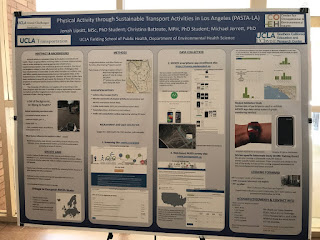
Today, I attended an event that touched upon the hazardous "toxics" that invade our lives. It focused heavily on the toxics that are preventable such as smoking, car smogs, and vape. I wasn't able to stay all 7 hours, but on the first hours, I examined the posters that were displayed outside the lecture room. The poster that got caught my eye the most was the effects of vape shops and their influence on other businesses in Los Angeles. Vapes or also known as e-cigarettes use have been rapidly growing throughout our city. Whether individuals use it to quit smoking or some do it for personal pleasure, most who use it say "it's 10x better than cigarettes, both for the body and for the environment". However, the study showed on the poster stated otherwise. These vape shops states that the indoor environment due to the smokes released in the shops cause occupational risks to employees and the pollutants from the shop eventually carry over to the nearby offices and businesses.

Furthermore, the advocates who spoke such as Jennifer McPartland, Katie Pelch, and Martha Dina Arguello reminded me of how essential public health is. But more importantly, how we spread awareness makes a difference. This is where art comes into role. Instead of flyers, scholarly articles, or statistics, a single picture can really be worth a thousand words. For smokers, a model or picture of a smoker's lungs can be far more effective than a graph of the number of deaths due to smoking/lung cancer.

This event was so informational and vital to my understanding of both public health and how art can be a driving force to grow awareness of the hurtful things that we do to our society. The event also reminded me of week 1's lecture of two cultures where art can bring a society together to advocate for our beliefs.
 Today, I attended an event that touched upon the hazardous "toxics" that invade our lives. It focused heavily on the toxics that are preventable such as smoking, car smogs, and vape. I wasn't able to stay all 7 hours, but on the first hours, I examined the posters that were displayed outside the lecture room. The poster that got caught my eye the most was the effects of vape shops and their influence on other businesses in Los Angeles. Vapes or also known as e-cigarettes use have been rapidly growing throughout our city. Whether individuals use it to quit smoking or some do it for personal pleasure, most who use it say "it's 10x better than cigarettes, both for the body and for the environment". However, the study showed on the poster stated otherwise. These vape shops states that the indoor environment due to the smokes released in the shops cause occupational risks to employees and the pollutants from the shop eventually carry over to the nearby offices and businesses.
Today, I attended an event that touched upon the hazardous "toxics" that invade our lives. It focused heavily on the toxics that are preventable such as smoking, car smogs, and vape. I wasn't able to stay all 7 hours, but on the first hours, I examined the posters that were displayed outside the lecture room. The poster that got caught my eye the most was the effects of vape shops and their influence on other businesses in Los Angeles. Vapes or also known as e-cigarettes use have been rapidly growing throughout our city. Whether individuals use it to quit smoking or some do it for personal pleasure, most who use it say "it's 10x better than cigarettes, both for the body and for the environment". However, the study showed on the poster stated otherwise. These vape shops states that the indoor environment due to the smokes released in the shops cause occupational risks to employees and the pollutants from the shop eventually carry over to the nearby offices and businesses. Furthermore, the advocates who spoke such as Jennifer McPartland, Katie Pelch, and Martha Dina Arguello reminded me of how essential public health is. But more importantly, how we spread awareness makes a difference. This is where art comes into role. Instead of flyers, scholarly articles, or statistics, a single picture can really be worth a thousand words. For smokers, a model or picture of a smoker's lungs can be far more effective than a graph of the number of deaths due to smoking/lung cancer.
Furthermore, the advocates who spoke such as Jennifer McPartland, Katie Pelch, and Martha Dina Arguello reminded me of how essential public health is. But more importantly, how we spread awareness makes a difference. This is where art comes into role. Instead of flyers, scholarly articles, or statistics, a single picture can really be worth a thousand words. For smokers, a model or picture of a smoker's lungs can be far more effective than a graph of the number of deaths due to smoking/lung cancer. This event was so informational and vital to my understanding of both public health and how art can be a driving force to grow awareness of the hurtful things that we do to our society. The event also reminded me of week 1's lecture of two cultures where art can bring a society together to advocate for our beliefs.
This event was so informational and vital to my understanding of both public health and how art can be a driving force to grow awareness of the hurtful things that we do to our society. The event also reminded me of week 1's lecture of two cultures where art can bring a society together to advocate for our beliefs.
Comments
Post a Comment